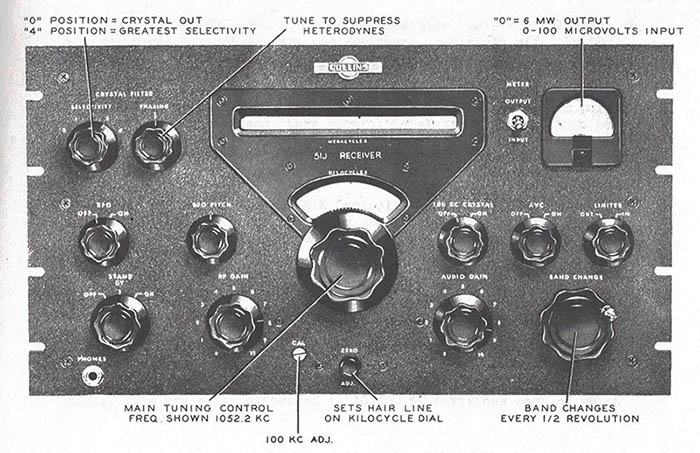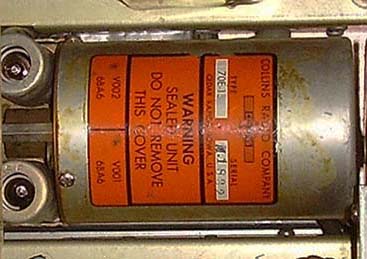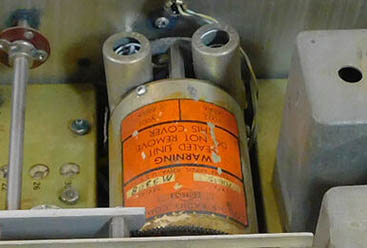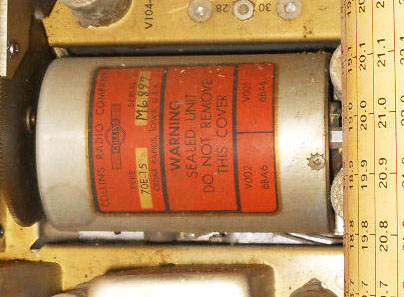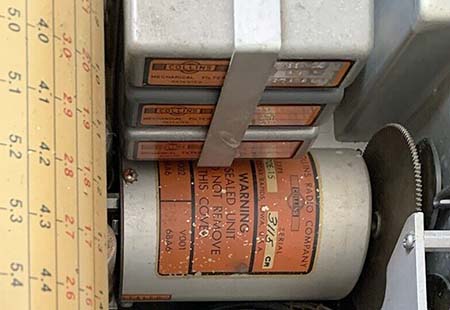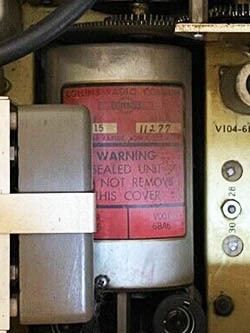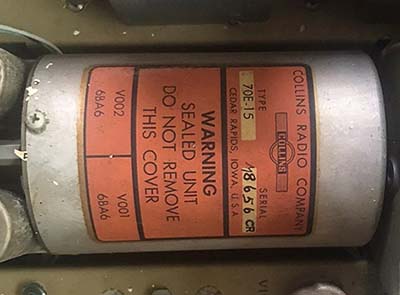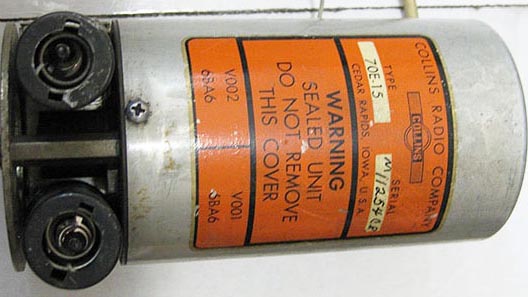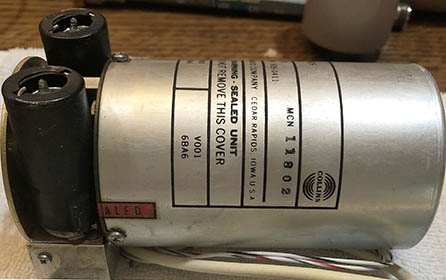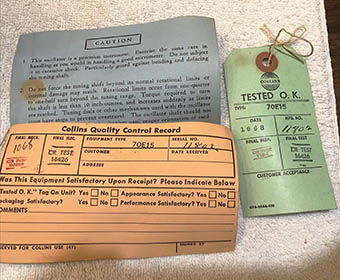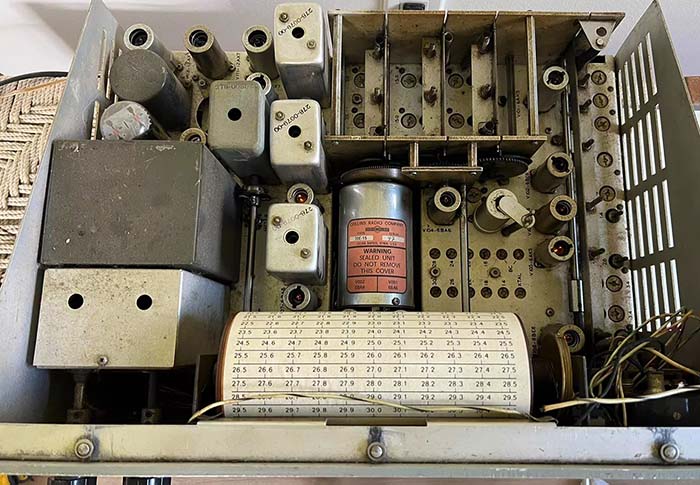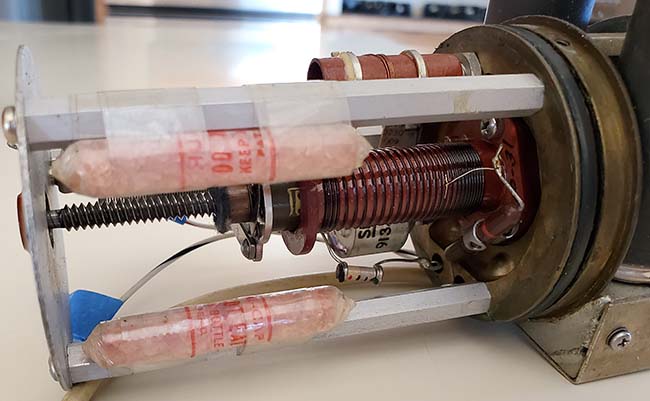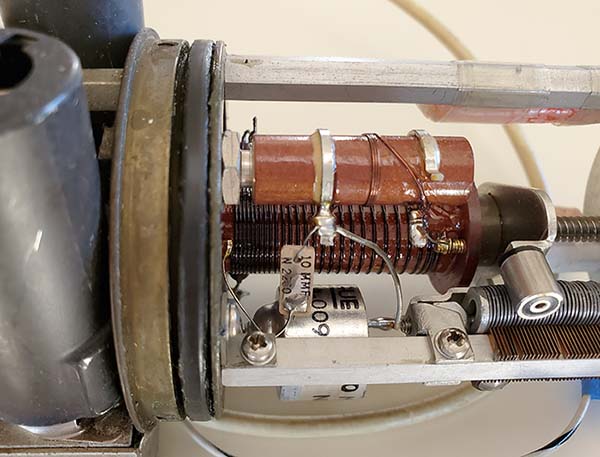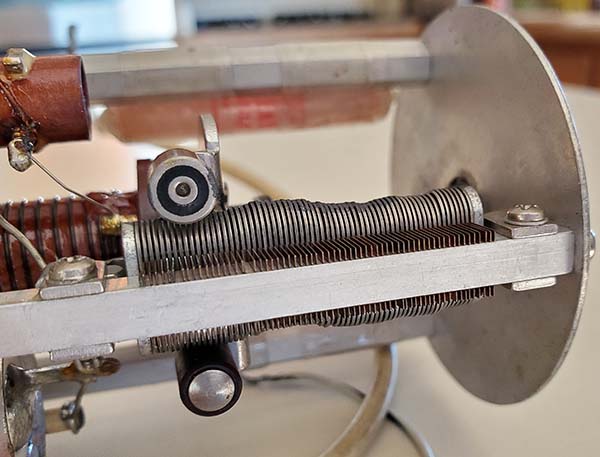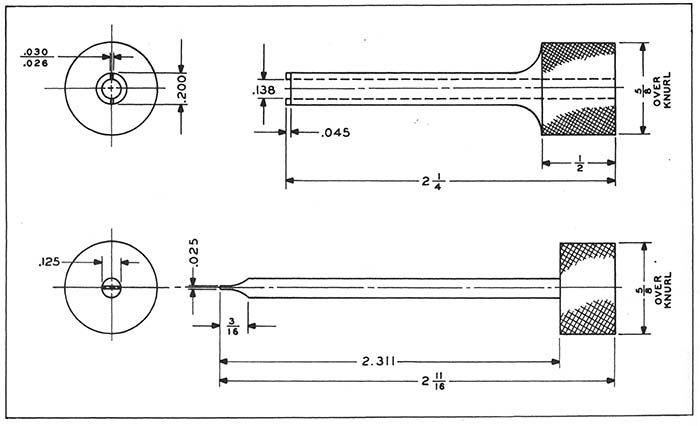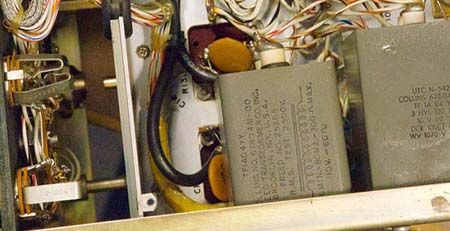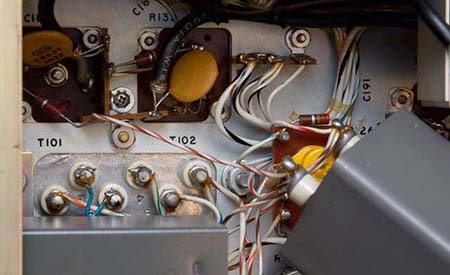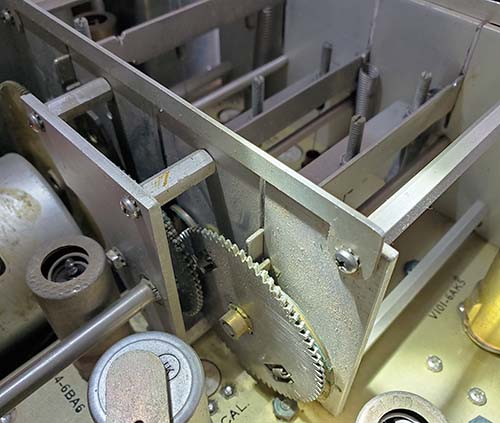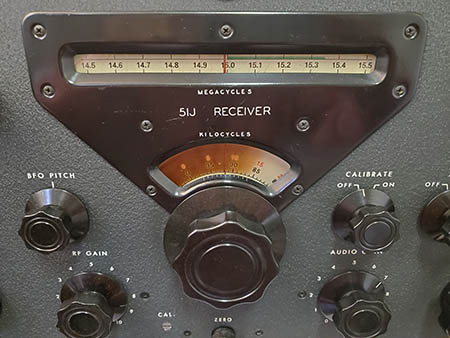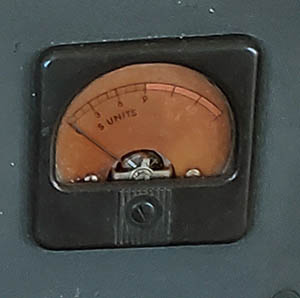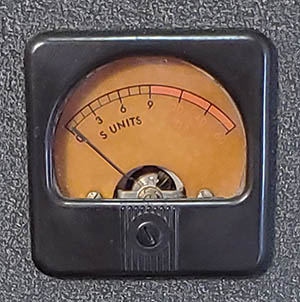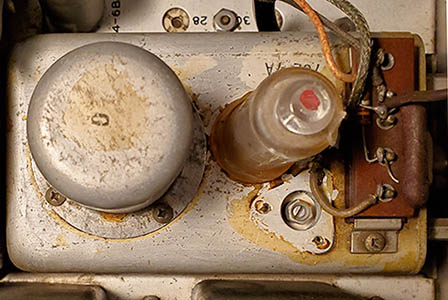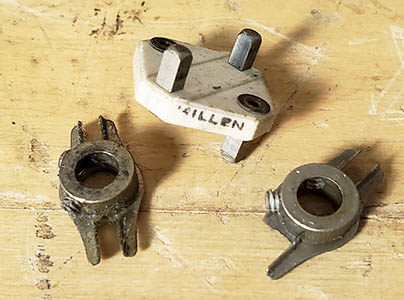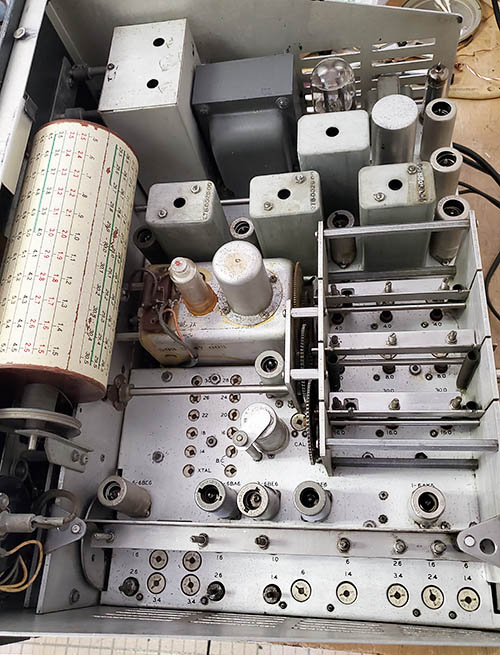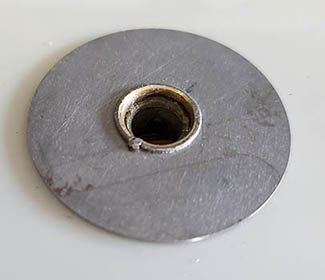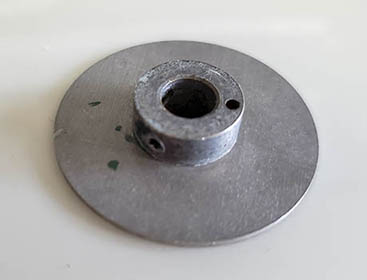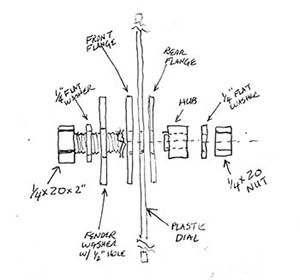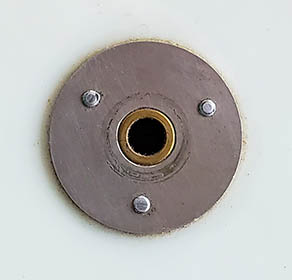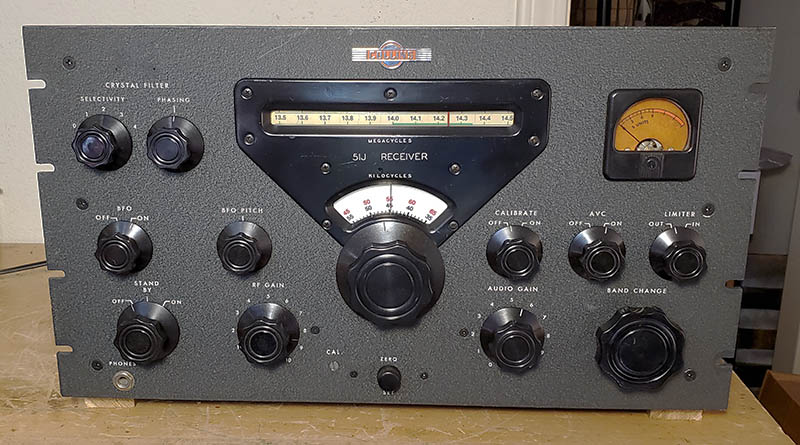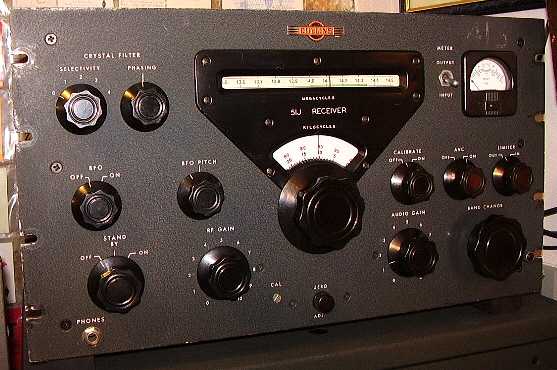|
Break-in Operation for the
R-388, 51J-3 and 51J-4 - What a Headache! - Perhaps the most inconvenient
requirement for the R-388,
51J-3 or the 51J-4 is how to provide the Break-in
function. Break-in requires an external +12vdc 200mA source that is switched
"on" when in the
"transmit" mode to isolate the receiver input and to mute the
audio output. Inside the receiver, relay K101 is operated by the
Break-in voltage and the
relay contacts disconnect the antenna input line, ground the receiver input
circuitry and also remove the voltage
from the IF amplifier plates to mute the receiver. There is also a neon
bulb as a protection device on the antenna line but this is mainly a
static voltage drain and not intended to handle large amounts of RF
energy. Break-in should be used when the receiver is paired with a
transmitter and both are using the same antenna switched by an external
T-R relay. Usually, the T-R relay does provide positive
isolation and many Dow-Key T-R relays had an additional spring-loaded
contact switch inside the
receiver-side coaxial fitting barrel that further increased receiver
isolation. These types of T-R relays afford protection when used with
the Standby position for muting in the short term and it's fine
for testing and preliminary set-ups but, ultimately, the permanent
set-up should be using the Break-in with the T-R relay to provide a positive
"double" disconnect of the antenna
line and providing the grounding that protects the receiver input,...just in case there's
a T-R relay failure and arcing happens inside the relay.
IMPORTANT NOTE: The front panel
STAND BY position does not actuate the Break-in relay.
The Break-in relay can ONLY be operated by applying +12vdc
Break-in voltage to pins 2 and 3 of the
REMOTE terminal strip (pin 1 provides a ground for
a cable shield.)
NOTE 1 - If you can't use an external +12vdc for Break-in: There are a couple of methods that provide
the +12vdc "Break-in" within the receiver. Either a small power supply
mounted under the chassis of the receiver or a voltage doubler circuit
that runs off of the 6vac tube heater supply. Since < 200mA is required
to operate the relay K101, very small components can be used for either
power supply circuit. NOTE 2
- For an easy external Break-in voltage - It's possible
to use a +12vdc "wall-wart" type of power supply for the Break-in
voltage. Use the T-R relay auxiliary contacts to switch the +12vdc. Or,
if the "wall-wart" is RFI noisy, switch the AC to the "wall-wart" using
the T-R relay auxiliary contacts. NOTE
3 - The 51J-1 and 51J-2 have conventional stand-by
provisions providing external relay connections that parallel the front
panel STAND BY
switch. The auxiliary contracts on the T-R relay can provide the remote
Stand By function. There isn't any antenna coil input protection circuitry
provided in these early version receivers.
BFO/IF "Inversion" - Selecting Upper or Lower Sideband
with the 51J -
The double conversion process in the
51J circuit involves mixing the incoming RF with a Crystal Oscillator
(using fundamental and harmonic frequencies) to create Odd and Even Bands
for the dual Variable IF that are in turn mixed with the PTO output. The PTO tunes from 3.0mc to 2.0mc
but the Even Bands use the Variable IF that tunes from 1.5mc to 2.5mc.
This requires using the formula PTO f - Vari IF = +500kc fixed IF
(mid-range example 2500kc-2000kc=+500kc.)
However, an Odd Band uses the Variable IF tuning 2.5mc to 3.5mc and this
requires using the formula PTO f - Vari IF = -500kc fixed IF (mid-range
example 2500kc-3000kc= -500kc.) The 500kc fixed IF signal is actually
changing phase (180º) between Odd
Bands and Even Bands. Since the BFO is a 500kc oscillator
heterodyning with that 500kc IF, when the 500kc fixed IF phase changes,
the BFO phase relationship inverts. This shows up, for example, as tuning in
an USB 14.200mc SSB signal will require the BFO to be to the right of
the center index line for proper demodulation. But, if an USB 15.035mc SSB signal is tuned in then the BFO
must be to the left of the center index line for proper demodulation.
Since there aren't any calibration index lines to comprise a scale for the BFO position, the 51J design
never intended using the BFO for selecting a specific sideband nor
in providing a "calibrated position" for the BFO (as with the
later R-390 and R-390A.) It's really not that much of a problem but it's
something that's noticed quickly when first operating a 51J receiver
nowadays and tuning in SSB signals.
| It's
easy (if you use the receiver a lot) to remember that on Odd Bands USB
reception will require the BFO index to be to the left of the center
mark. If you're on an Even Band, USB will require the BFO index to be to
the right of the center mark. Or,...since 80M and 40M are both Odd Bands
and LSB is normally used there, have the BFO index to the right of the
center mark for those two ham bands. But, 15M is also an Odd Band but
USB is normally used there so the BFO index is set to the left of the
center mark for 15M. Even Bands are 20M, 17M and 10M and all typically
are USB so the BFO index is set to the right of the center mark for
those ham bands. The upper portion of 10M is an Odd Band so BFO to the
left for USB. It sounds confusing but once you've operated the
receiver a few times on SSB with taking into account the BFO inversion between Odd
and Even Bands, selecting the proper sideband is easy (see drawing to
the right.)
IMPORTANT NOTE: You have to be
sure that the BFO knob index is mounted correctly on the BFO shaft.
Setting up the
correct BFO knob position is covered in detail in any of the 51J
receiver's alignment procedure. The basic set up is to first rotate the BFO knob one full turn
clock-wise, then continuing C-W, set the BFO to the highest
frequency (fully unmeshed C) then, without moving the BFO shaft, mount the BFO
knob so its index is
at 90º
C-W from vertical. Then set the BFO index to vertical and align the BFO
coil assembly adjustment to 500kc. With this setting, if the BFO is rotated from
index-vertical to the right (or C-W) the BFO frequency will
increase from 500kc. If the BFO is rotated from index-vertical
to the left (or C-C-W) then the BFO frequency will decrease from
500kc. |
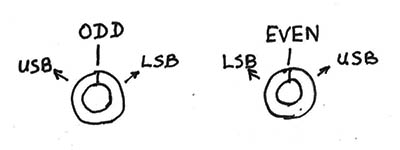
BFO Position for Sideband Selection |
Even Collins had a hard time with the Odd-Even Band changes and the
relationship with the BFO operation. When the 51J was designed at the
end of WWII, a BFO was only used for CW reception and, since a CW signal
has no sidebands, the position of the BFO didn't matter as long as it
provided a heterodyne. By the time the 51J-4 was introduced, SSB had
been developed and was being promoted by Collins. The 51J-4 manual has a specific set of instructions for determining
what Collins thought was the
proper setting of the BFO for SSB signals when using the J-4. The procedure requires
determining center frequency of a marker signal and then tuning below
the f center for a carrier level drop of 18db and then adjusting the BFO CCW for zero
beat and noting the knob's index position. The same procedure is again performed with
by tuning above f center for an 18db drop and tuning the BFO CW for zero
beat and noting the knob's index position. NOTE: It's strange that
the Collins instructions actually states the signal levels and the
signal drop as "3 S-units" and, of
course, all of the 51J-4 receivers had Carrier Level meters that read in
"db over" but Collins did provide the 18db level in parentheses. The instructions finish up by stating that
if the SSB signal can't be demodulated with the BFO in the proper CCW
position then rotate the BFO control to the proper CW position. In other
words, there's no specification of either "upper" or "lower" sideband
mentioned since obviously that changes depending on whether the band
being used is Odd or Even, which isn't mentioned either. It must have become too convoluted to explain
at a time when SSB transmissions were just becoming popular and just
beginning to be heard on the
air, so Collins avoided
it altogether. It also seems strange that Collins (at the time)
didn't mention the BFO inversions since this changing BFO relationship would
have affected reception of RTTY FSK signals. The BFO position determines whether the RTTY
FSK signal is
going to be received "Mark high f" or "Mark low f."
Of course, it depended on the type of RTTY TU. Those TUs that ran off of
the IF and supplied their own BFO might not have been affected.
However, some of the TUs were audio input types and relied on the
receiver BFO. These would have definitely been affected by the Odd-Even BFO
inversion but most RTTY audio TUs
had the ability to invert the relationship, if necessary, for this very
reason. Since the BFO
inversions are a product of the Vari-IF and PTO relationship, they will be experienced with all versions of the
51J series. I guess it's just one of
the 51J "oddities."
Communications-grade Audio, Loudspeakers and External Audio
Amplifiers for the 51J Series - If you're expecting high
fidelity audio from any of the 51J receivers, you're in for a
disappointment. The initial intent of the receiver was communications
and especially for receiving data-type transmissions. Communications-grade audio
response was generally considered 300hz to 3000hz for voice
transmissions. For CW or data, the audio bandwidth could be much
narrower. Most military transmitters (and most amateur transmitters at
the time) that were used for voice
communications kept the audio response approximately from 300hz to
3000hz. This was to assure that the best intelligibility was available
at the receiving-end. Voice transmitters, if their audio response was
set up to favor the lower voice frequencies, would have to lower the
audio gain level in the speech amp which in turn lowered level of
modulation. The voice's low frequencies have a lot of "speech power"
that would easily cause over-modulation. Most amateur and military voice
transmitters were fairly low power and
if they were set up with "bassy, low-modulation level" audio, the signal intelligibility
would be lost and copy would be difficult, if not impossible. All 51J-1
and 51J-2 receivers
have audio specification of 200hz to 2500hz at -6db down. Additionally,
the 51J-1 and 51J-2 have a very narrow IF bandwidth of about 4kc at
-6db. The R-388,
51J-3 and 51J-4 have audio specifications of 200hz at -3db down on the low end and 2500hz
at -7db down on
the high end with an IF bandwidth of about 6kc at -6db and 1.5 watts available audio power at less
than 15%
distortion. The 51J-4 widened the IF band width a bit more than that,
using a 3pf IF coupling C where the R-388 used a 2pf IF coupling C,
and added mechanical filters to the 500kc fixed-IF
that actually determined the band width and created a steep-sided, flat topped bandwidth that, while great for
selectivity, created serious audio issues in the AM mode using the 6kc
mechanical filter. Certainly not impressive
audio specs from any of the 51J Series,...especially if you're an
audiophile. But, the 51J receivers are "communications receivers" and
their audio specifications are appropriate for that type of end-use.
All of the advertising or
the manuals never specified a particular matching speaker for any of the
early 51J series of receivers. The 51J-1 and J-2 manuals provide
dimensions of the intended loudspeaker and these dimensions describe the
Collins 270G-1 (used an 8" loudspeaker.) The 51J-4 manual actually specifies the 270G-3 loudspeaker.
The 270G-3 used a 10" loudspeaker. During early production there was a
270G-2 10" loudspeaker available. There is conflicting information out
there (even from Collins) but it seems that the 270G-2 was identical to
the 270G-3 with the exception of the three small vertically-spaced holes
towards the front on each side of the cabinet for installing rack-mount brackets. Some
sources say it's the other way around, that is, the 270G-3 had the rack
bracket holes but the 1959 Collins production catalog shows the 270G-3
loudspeaker without the mounting holes for the rack brackets. Also, in
the 1959 Collins catalog the 270G-3 is listed as 6-8Z ohms however
actual impedance measurements of original
loudspeakers will normally show they are 4Z voice coils. Note that this
is a nominal impedance shown and that would vary depending upon
how the measurement is made, specifically the frequency employed. Figure
that the impedance specified is "NOMINAL" and whether the testing shows
4Z, 6Z or 8Z, all 270G-3 loudspeakers sound great when connected to the
4Z output terminals of any 51J receiver.
R-388 receivers were generally used for specific military set-ups such
as RTTY or other data transmissions where a loudspeaker would be part of
a larger, rack-mounted collection of equipment. In addition to the
rack-mounting option of the 270G-2, there also was a
rack mounted dual speaker system available for diversity RTTY set-ups. There was a USN version of the R-388 referred to
as the AN/URR-23-A that came in a standard Collins cabinet, CY-1235/U and included
the 270G-3 speaker (mil ID: LS-199/U.) The 51J-2 was also supplied in a similar fashion and
designated as the AN/URR-23 (no -A.)
For a vintage mil-rad station, perhaps
the easiest speakers to find (that are period and manufacturer correct)
would be either the Collins 270G-1, an 8" speaker, or the Collins 270G-3, a 10" speaker. The 270G-1 was typically supplied with the 75A-1
receivers and the speaker cabinet had the Collins "winged" emblem on the front with chrome
trim strips with a felt-flocked perf-metal grille (usually a sort of
brownish-maroon color.) The 270G-1 also has a serial number tag mounted
inside the cabinet showing the model designation and the serial number.
The 270G-3 was typically supplied with the 75A-2, 75A-3 and 75A-4
receivers and these cabinets don't have the Collins WE and have black
trim strips with an white-cream color felt-flocked grille. The 270G-3
doesn't have a serial number tag and wasn't assigned a serial number.
Either of these Collins speakers are fine sounding, communications-grade
reproducers and, though usually outrageously expensive, they are
easy to find. However, any 4.0Z speaker will function fine with the 51J
receivers. There's not too much of an advantage in using a high-quality,
large diameter speaker installed in a bass reflex cabinet because the
audio output circuitry of any of the 51J Series receivers was always
"communications grade" in quality. The audio range available with all
51J receivers lacks any significant bass since the audio output
frequency response was rolled-off starting at 200hz on the low end and
the upper limit roll-off was at 2500hz while the audio power can only
produce about 1.5 watts maximum. Even the latest version, the 51J-4,
still has audio that was specified as 200hz at -3db down to 2500hz at -7
db down in the manuals with the 1.5 watts output power maximum (at <15%
distortion.) These less-than-impressive specifications will become more
and more apparent with better quality, high fidelity speaker systems.
Using the 600Z output to drive a loudspeaker through an appropriate
matching transformer is also an option. Using a good quality transformer
and a typical 8Z or 4Z loudspeaker will result in typical communications
audio reproduction. Whenever I've used the 600Z output to drive a
600Z/8Z matching transformer and an 8Z loudspeaker, I've found the audio
to sound "thin" and not nearly as "clean" as the 4Z output. I've tried
several 51J/R-388 receivers and multiple speaker set-ups and I always
have the same results. With the very late R-388 receivers and all but the earliest of the 51J-4 receivers, the Diode Load was brought out to the rear chassis apron
as a test point jack. It would be possible to use a shielded cable
connected to the Diode Load and run that to the input of a High Fidelity
audio amplifier (using the aux. input or some other fairly Hi-Z input) to
drive a quality loudspeaker. You would lose the Noise
Limiter function but it was designed for repetitive pulse noise that
isn't heard very much nowadays. Also, the 51J-4's 6kc mechanical filter will
still be limiting any high quality AM reproduction so very few enthusiasts have
bothered with the external Hi-Fi amp set-up. However, it does depend
upon what type of stations are listened to. AM Broadcast from local
stations will sound pretty good on a J-4 if the receiver is tuned to the
carrier plus one
sideband allowing the audio to go up to about 6000hz (theoretically,...and
since AM-BC stations are limited to a 10kc bandwidth their transmitted
audio should only be up to about 5000hz,...theoretically.) Since there's no fading
or phase distortion with ground wave signals, this type of
reception might benefit from an external audio amplifier with bass and
treble controls to enhance the audio frequency response. Any SW-BC or AM
ham transmissions will be subject to skywave propagation conditions and
lack-luster signal strength that usually seriously affects audio
quality. Limitations on any local AM-BC would be in the program material
and that's pretty much the same for any AM-BC or SW-BC.
Since the 51J receivers have always been considered "communications
receivers," it's not unexpected that the standard
Collins communications-grade loudspeakers, the 270G-1 or the 270G-3, will give the best
results when used with any of the 51J receivers.
UPDATED NOTE: On the 51J driving large
loudspeakers in bass-reflex enclosures - Nov 2025: I may have to modify
what I said about using a 51J receiver with a large speaker not sounding
very well. I've had my 51J-3 SN:1999 connected up to a 12" loudspeaker
that's installed in a wall-corner-mount bass-reflex enclosure. I have the
enclosure mounted up next to the ceiling which puts the speaker
enclosure about ten feet away from the listening position with the bass
reflex port about 6 feet off the floor. The 12"
loudspeaker has an 8Z voice coil and it's connected to the 4Z output on
the receiver. I've been listening to this set up for several days now
and I'm surprised at how good it sounds. Some bass response,...not a lot,...but certainly some, which is a surprise. The big improvement
I think is due to
the distance that the speaker enclosure is from the listening position.
That distance requires the Audio Gain to be increased a little bit and
that helps the bass response. Also, the highs (if there are any) tend to
"roll off" with the distance but the lows don't. It's a really nice
sounding set up and totally unexpected for a 51J receiver. So, large
speakers and enclosures can be beneficial to listening pleasure, even
when using a 51J receiver. It depends on the loudspeaker's cone
suspension being the older formed paper type and then the location in
the room and its distance from the listener. A small table loudspeaker
setting on top of the receiver directly in front of the listener at
about two feet distance is probably the worst possible speaker location
for pleasant sounding audio,...maybe good for weak CW or SSB signals but
terrible for mellow sounding AM or music broadcasts.
Cross-Modulation with R-388, 51J-3 and 51J-4 - The
first receivers, the 51J-1 and 51J-2, used RF transformers in the Ant/RF
input section of the receiver but this resulted in a fixed antenna input
impedance of 300 ohms. The Army found this terribly inconvenient since
most of their antennae were whip verticals or dipoles with impedances a
lot less than 100 ohms, let alone
300 ohms! Collins
modified the RF/Ant input section when implementing the changes needed
for the R-388 receiver. The change removed the primary winding on the
coils and just used a parallel LC for tuning the Ant/RF along with
adding an Antenna Trim to allow matching the antenna low impedances
better. It all works fine except if there's a really strong RF field
present. This could be a nearby AM-BC station or a neighboring ham
running a high power transmitter. To have a strong enough RF level that
could cause cross-modulation generally requires using a very large
random length wire antenna that's
directly connected to the receiver antenna input. The receiver's parallel LC Ant/RF
input section doesn't have much selectivity and that's why it's possible
for cross-modulation to happen if the RF field is sufficiently strong. The Army used mostly whip antennae and
so it wasn't much of a problem for them. I've heard about this
cross-modulation problem with the R-388 but I've never experienced it.
Certainly, in large urban areas where powerful AM-BC stations might be
nearby and numerous, along with the possibility of neighboring hams operating
powerful transmitters, the cross-modulation issue might be more likely
to occur. Using an end-fed wire antenna without any type of matching
network (tuner) will contribute to the susceptibility to cross-modulation. Here in Western Nevada,
I've always used large wire antennae but I've always used dipoles fed
with open wire feedline in combination with a selective type of antenna tuner. I
believe that the "tuned" antenna, which is essentially a selective LC
combination,
adds another "tuned stage" ahead of the receiver to compensate for the
reduced selectivity in the Ant/RF input section. Using large broad-band
or untuned (non-resonant) antennae might tend to
result in the R-388 being more susceptible to cross-modulation. A
selective "tuned" large wire antenna seems to work for me. Also, even if
I'm just listening to station outside of the ham bands, I'll always
"tune" the antenna for that frequency of reception. Again, the
tuning and resulting high-Q of the antenna might be
why I haven't experienced any cross-modulation issues. |
